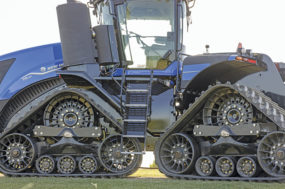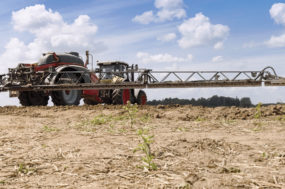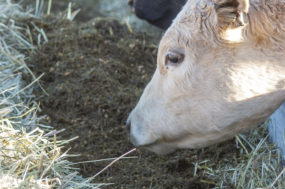One of us asked about feeding with one of the tractors pulling the feed wagon. We got a long, detailed reply.
“When you rely on a tractor, you have a problem if the temperature drops really low because then the tractor don’t want to start. We’ve never had a team get stuck in the snow. If you get distracted, the team will not run into a boulder or a tree.
If it gets really cold, the cowboy drivin’ the tractor will freeze. Once you’re in the feeding area with the team, everyone on the feed wagon or sleigh can stay warm by throwing hay off to the cattle.” And that was just the start of it.
There was a commotion in the stable. One of the draft horses could not, or would not, get up. All hands were working to get the mare’s legs under her as they rolled her from her side to a position with her legs under her in the hope that it would help her stand.
There was a concern that she was sick since she appeared unable to stand. After spending close to an hour helping as best we could, the horse once again rolled back on her side.
Then she reached her head toward a bale of hay that had been moved in the area in hopes of propping her up – and took a bite of it and began chewing.
At that, the foreman cut loose with a string of profanity at the horse. He then told us there was nothing in the world the matter with that horse. She just took a notion that she wasn’t ready to get up yet.
Kate and Brownie were Dad’s team of workhorses. They were not huge, like the Clydesdale or Persian draft horses, but I remember them being noticeably larger than Patsy, the saddle horse.
I remember getting to ride on Kate when Dad was working the team. When my younger sister Janeen was big enough to join us, she would sit behind me on Kate’s broad back. I asked Dad why I couldn’t ride on Brownie by myself. He told me that he did not trust Brownie like he did Kate.
In southeast Idaho, Dad would change the hayrack from the wagon chassis used in the summer to the four-runner sleigh for winter use. I went with Dad one trip with Kate and Brownie pulling the sleigh to a neighbor’s place where Dad had purchased a haystack.
When Dad had loaded the sleigh with a pitchfork, we headed home. Along the way, the runners slipped off the high spot of the road, and the hay left the rig. I was sitting on top of the load and ended up in a snow bank covered with hay up to my chin. I remember Kate and Brownie standing by nonchalantly while Dad hot-footed it to find me.
Haying season found Kate and Brownie pulling a dump rake. The hay had been mowed, and it lay flat all over the field. Windrowers were still 20 years into the future.
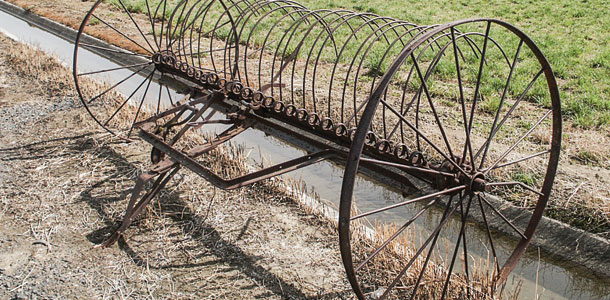
The dump rake moved crosswise over the field, and when the teeth filled, the operator would engage the trip mechanism.
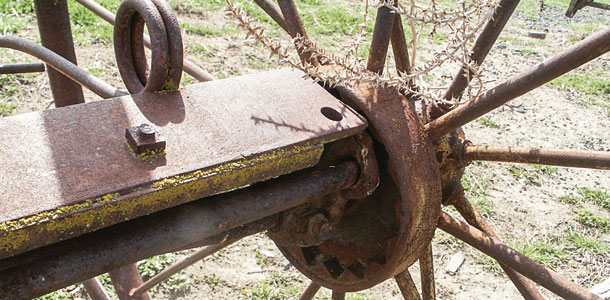
Then a set of gears inside one of the wheels would power the apparatus that raised the rake teeth and dropped them again. This left a row of hay the width of the dump rake and perpendicular to it.
This continued across the field, and on the next pass the idea was for the operator to line up the “dumps” into rows. The rake then followed the rows, forming them into “shocks” or piles which, when dry, were loaded onto the hay wagon with pitchforks.
Extended family and neighbors worked together to get everybody’s hay up at harvest time. The host farm provided the huge dinner at noon, and everyone had to be back at their own place in time to milk cows at the end of the day.
If someone was sick or injured, his hay got cut and raked and hauled and stacked just the same. Thankfully, we see the same attitude of caring and sharing in agriculture today.
As we surround the Thanksgiving feast table, we should express gratitude for those who went before us, also that we have the machinery and the technology so that it no longer takes 90 percent of the population to feed the country.
And I hope that in your home among your blessings is an upcoming generation who knows to look out for those around them. Carry on. FG
PHOTOS
PHOTO 1: A dump rake (minus the seat) sits forlorn but not forgotten in the Dave Miller antique collection near Royal City, Washington.
PHOTO 2: The gear mechanism powers the rake teeth when the operator wants to dump the load. Photos by Brad Nelson.




